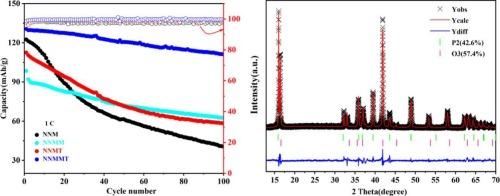双掺杂调控P2/O3共相钠离子电池的结构与电化学性能研究
IF 3.3
4区 材料科学
Q3 CHEMISTRY, PHYSICAL
引用次数: 0
摘要
合成了微量Ti/Mg共掺杂的Na0.8Ni0.35Mn0.48Ti0.12Mg0.05O2 (TiMg-NNM)阴极,其中Ti离子位于过渡金属层,Mg离子掺入钠层。共掺杂扩大了层状结构内的na层间距,从而降低了na离子的扩散势垒。由于强大的TiO键和Mg离子的柱状效应,结构稳定性显著增强,这也有助于减少与电解质的表面副反应。这些优点赋予了TiMg-NNM阴极在1C下具有130.5 mAh/g的高可逆容量,在1C下100次循环的容量保持率为85.8%,远高于NNM的35.6%。通过Mg和Ti的掺杂,增强了P2和O3相的协同作用,使所制得的NNMMT具有较高的电化学稳定性。该研究为设计具有更好结构和界面稳定性的高性能sib层状氧化物正极材料提供了实用的方法和新的视角。本文章由计算机程序翻译,如有差异,请以英文原文为准。

Study on the structure and electrochemical properties of double-doped regulated P2/O3 cophasic sodium-ion batteries
A trace Ti/Mg co-doped Na0.8Ni0.35Mn0.48Ti0.12Mg0.05O2 (TiMg-NNM) cathode was synthesized, where Ti ions are located in the transition metal layers and Mg ions are incorporated into the sodium layers. The co-doping expands the Na-layer spacing within the layered structure, thereby lowering the diffusion barrier for Na-ions. Structural stability is significantly enhanced due to the robust Ti![]() O bond and the pillar-like effect of Mg ions, which also helps to minimize surface side reactions with the electrolyte. The merits endow a high reversible capacity of TiMg-NNM cathode with 130.5 mAh/g at 1C, the 85.8 % capacity retention rate at 100 cycles at 1C, much greater than 35.6 % of NNM. The synergistic effect of P2 and O3 phases was strengthened by the doping of Mg and Ti, so that the obtained NNMMT had high electrochemical stability. The research offers a practical approach and fresh perspectives for designing high-performance layered oxide cathode materials with improved structural and interfacial stability for SIBs.
O bond and the pillar-like effect of Mg ions, which also helps to minimize surface side reactions with the electrolyte. The merits endow a high reversible capacity of TiMg-NNM cathode with 130.5 mAh/g at 1C, the 85.8 % capacity retention rate at 100 cycles at 1C, much greater than 35.6 % of NNM. The synergistic effect of P2 and O3 phases was strengthened by the doping of Mg and Ti, so that the obtained NNMMT had high electrochemical stability. The research offers a practical approach and fresh perspectives for designing high-performance layered oxide cathode materials with improved structural and interfacial stability for SIBs.
求助全文
通过发布文献求助,成功后即可免费获取论文全文。
去求助
来源期刊

Solid State Ionics
物理-物理:凝聚态物理
CiteScore
6.10
自引率
3.10%
发文量
152
审稿时长
58 days
期刊介绍:
This interdisciplinary journal is devoted to the physics, chemistry and materials science of diffusion, mass transport, and reactivity of solids. The major part of each issue is devoted to articles on:
(i) physics and chemistry of defects in solids;
(ii) reactions in and on solids, e.g. intercalation, corrosion, oxidation, sintering;
(iii) ion transport measurements, mechanisms and theory;
(iv) solid state electrochemistry;
(v) ionically-electronically mixed conducting solids.
Related technological applications are also included, provided their characteristics are interpreted in terms of the basic solid state properties.
Review papers and relevant symposium proceedings are welcome.
 求助内容:
求助内容: 应助结果提醒方式:
应助结果提醒方式:


